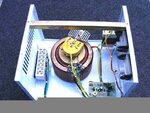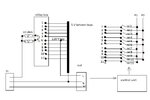Okada
Banned
I am designing a PIC18F46K22 based Stabilizer. I read about CVTs (Constant Voltage Transformers) and found that in that the secondary will be saturated and output is not pure sine wave but instead the peak will be flattened and hence I am trying to design my own stabilizer. Cost is not a problem. I want to make a good design.
These are my Transformer Calculations. Are these correct ? What will be the normal number of primary turns in a stabilizer transformer ? For calculation purposes I have assumed primary number of turns as 100. If this can be reduced to 50 then that is also fine.
110V to 290V
Vpri/Vsec = N
Npri/Nsec = N
Nsec = Npri/N
290V/230V = 1.26, Nsec = 100 / 1.26 = ~ 79
270V/230V = 1.174, Nsec = 100 / 1.174 = ~ 85
250V/230V = 1.087, Nsec = 100 / 1.087 = ~ 92
230V/230V = 1, Nsec = 100 / 1 = 108.7 = 100
210V/230V = 0.91, Nsec = 100 / 0.91 = ~ 110
190V/230V = 0.826, Nsec = 100 / 0.826 = ~ 121
170V/230V = 0.739, Nsec = 100 / 0.739 = ~ 135
150V/230V = 0.652, Nsec = 100 / 0.652 = ~ 153
130V/230V = 0.565, Nsec = 100 / 0.565 = ~ 177
110V/230V = 0.478, Nsec = 100 / 0.478 = ~ 209
Instead of other type switching methods I will just switch the correct tap to get constant 230V output. Number of Relays required is not a problem. I will be using
I will be using a board similar to this but with 10 Relays. I will use same Omron Relays used in this board. These will be a 20x4 LCD also.
https://www.sainsmart.com/omron-8-c...uino-mega2560-r3-uno-r3-raspberry-pi-arm.html
How to choose core for the transformer ?
- - - Updated - - -
Edit:
The tarnsformer min and max voltages will be
110/1.26 = 87V
290/0.478 = 607V
Is this 607V a normal voltage in a bulky transformer based stabilizer ? Can I get relays for these voltages. The relays will turn to NO position to provide 230V output. Relays with higher voltages at its input will be in NC position.
These are my Transformer Calculations. Are these correct ? What will be the normal number of primary turns in a stabilizer transformer ? For calculation purposes I have assumed primary number of turns as 100. If this can be reduced to 50 then that is also fine.
110V to 290V
Vpri/Vsec = N
Npri/Nsec = N
Nsec = Npri/N
290V/230V = 1.26, Nsec = 100 / 1.26 = ~ 79
270V/230V = 1.174, Nsec = 100 / 1.174 = ~ 85
250V/230V = 1.087, Nsec = 100 / 1.087 = ~ 92
230V/230V = 1, Nsec = 100 / 1 = 108.7 = 100
210V/230V = 0.91, Nsec = 100 / 0.91 = ~ 110
190V/230V = 0.826, Nsec = 100 / 0.826 = ~ 121
170V/230V = 0.739, Nsec = 100 / 0.739 = ~ 135
150V/230V = 0.652, Nsec = 100 / 0.652 = ~ 153
130V/230V = 0.565, Nsec = 100 / 0.565 = ~ 177
110V/230V = 0.478, Nsec = 100 / 0.478 = ~ 209
Instead of other type switching methods I will just switch the correct tap to get constant 230V output. Number of Relays required is not a problem. I will be using
I will be using a board similar to this but with 10 Relays. I will use same Omron Relays used in this board. These will be a 20x4 LCD also.
https://www.sainsmart.com/omron-8-c...uino-mega2560-r3-uno-r3-raspberry-pi-arm.html
How to choose core for the transformer ?
- - - Updated - - -
Edit:
The tarnsformer min and max voltages will be
110/1.26 = 87V
290/0.478 = 607V
Is this 607V a normal voltage in a bulky transformer based stabilizer ? Can I get relays for these voltages. The relays will turn to NO position to provide 230V output. Relays with higher voltages at its input will be in NC position.

